
Sharm El-Sheikh
![]()
| Sharm El Sheikh is a popular tourist site located on the southern tip of the Sinai peninsula, between the Gulf of Aqaba in the southeast and the Gulf of Suez in the southwest with the Red Sea to the south. It is known for its underwater activities, particularly scuba diving. Several coral reefs teeming with colorful fish are only a few feet from the shore. |
![]()
 The Coral Bay Hotel in
the early morning hours. The hotel is part of a large complex that is beside a private
bay, almost 2 kms wide, and some 11 kms north of Sharm el-Sheikh with a view of Tiran
Island. The Red Sea and the protected United Nations Ras Mohamed Marine Natural Park are
popular with divers and snorkelers.
The Hotel has three small swimming pools close to the coral reef where you can swim among
the colorful fish.
The Coral Bay Hotel in
the early morning hours. The hotel is part of a large complex that is beside a private
bay, almost 2 kms wide, and some 11 kms north of Sharm el-Sheikh with a view of Tiran
Island. The Red Sea and the protected United Nations Ras Mohamed Marine Natural Park are
popular with divers and snorkelers.
The Hotel has three small swimming pools close to the coral reef where you can swim among
the colorful fish.
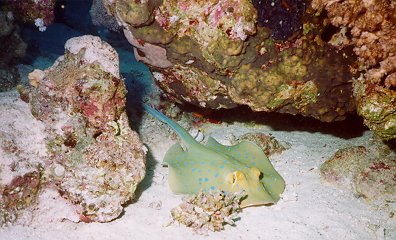 Blue Spotted Stingray seen while scuba
diving in the Near Garden. We went on
two dives; one to the Near Garden and another to the Far Garden.
Blue Spotted Stingray seen while scuba
diving in the Near Garden. We went on
two dives; one to the Near Garden and another to the Far Garden.
An Angelfish swims amidst the
colorful Coral in the Gulf of Aqaba.
There is pink
soft coral (top middle) and some Gorgonian
fan coral in the foreground.
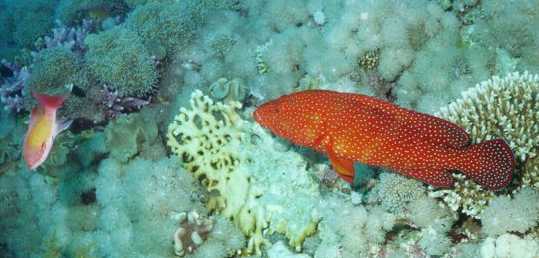 A
Coral Grouper swims
near some Net
Fire Coral (Millepora dichotoma). Nearby is a small fish that
may be an Anthias Squamipinnis.
A
Coral Grouper swims
near some Net
Fire Coral (Millepora dichotoma). Nearby is a small fish that
may be an Anthias Squamipinnis.
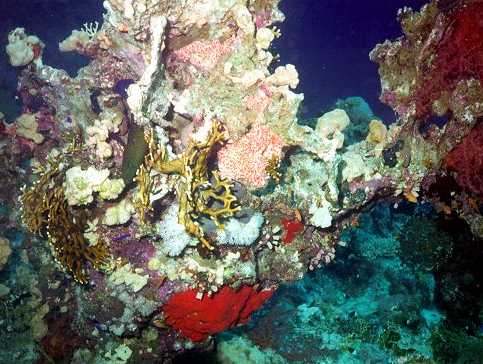 A colorful coral clump that we saw while scuba diving.
A colorful coral clump that we saw while scuba diving.
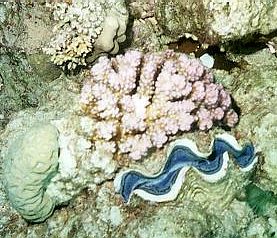
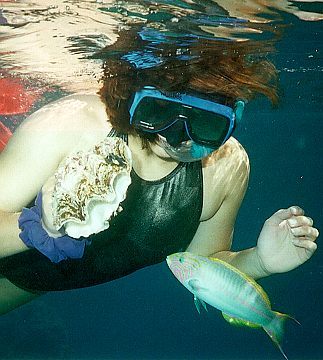
While snorkeling at the Coral Bay Hotel, a wrasse became my best friend
when I picked up a vacant giant clam shell. An "occupied" Giant
Clam (Tridacna maxima) shell is shown at right.
A red sea Sohal
Tang (Acanthurus sohal). Notice the orange 'tang' on the
caudal peduncle just in front of the tailfin and the fluorescent blue
fringe on the edges of the fins. This fish is also called the Zebra
Surgeon, Majestic tang, Majestic Surgeon, Zebra Tang, and Arabian Tang. It
is found in the Red Sea, to the Arabian Gulf, and the Arabian Sea,
sometimes in large aggregations, but usually in solitude. These Tangs
commonly inhabit the reef plateau just before the slope, and are generally
found in depths of less than 20 meters (65').
Lion fish seen while snorkeling at the
Coral Bay Hotel. This brightly
colored fish is usually found in coral reefs, especially in shallow waters
hovering in caves or near crevices. They are among the few fish that will
lay in wait for its prey and then engulf it with its very large mouth. Lion
fish have venomous fin spines that can produce painful puncture wounds.
Fatalities, however, are rare. The fish have elongated dorsal fin spines
and enlarged pectoral fins and each species has a particular pattern of zebra like
stripes.
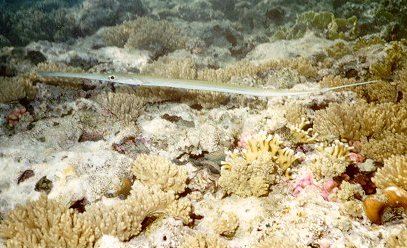 A cornet fish seen while snorkeling at the
Coral Bay Hotel. The cornet fish is a pipe-shaped fish up to 160cm long
often seen hunting along the reef in flotillas, ready to dash in at great
speed to grab unwary prey. It is not to be confused with the trumpetfish,
which is much stubbier in appearance. The cornet fish,
Fisttilariapetimba, belongs to the family Fistulariidae with the characteristic extremely
long tube-like snout and a caudal fin with the middle rays drawn out into a long filament.
A cornet fish seen while snorkeling at the
Coral Bay Hotel. The cornet fish is a pipe-shaped fish up to 160cm long
often seen hunting along the reef in flotillas, ready to dash in at great
speed to grab unwary prey. It is not to be confused with the trumpetfish,
which is much stubbier in appearance. The cornet fish,
Fisttilariapetimba, belongs to the family Fistulariidae with the characteristic extremely
long tube-like snout and a caudal fin with the middle rays drawn out into a long filament.
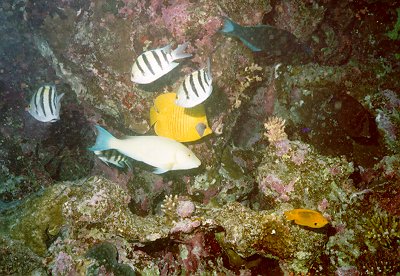 Assorted fish including a
Masked Butterfly Fish and several
Sergeant Majors seen while scuba
diving in the Gulf of Aqaba.
Assorted fish including a
Masked Butterfly Fish and several
Sergeant Majors seen while scuba
diving in the Gulf of Aqaba.
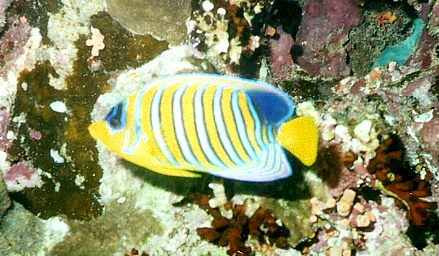 A Royal
(Regal) Angelfish (Pygoplites Diacanthus) seen in the Red Sea near
Sharm el Sheikh. The royal angelfish
belongs to the family Pomacanthidae and to the subspecies of angelfish. They
are mostly yellow with vertical white bands edged with blue. Royal
angels are found ranging widely over rich coral areas, ducking in and out
of crevices. They grow to about 25-30 cm.
A Royal
(Regal) Angelfish (Pygoplites Diacanthus) seen in the Red Sea near
Sharm el Sheikh. The royal angelfish
belongs to the family Pomacanthidae and to the subspecies of angelfish. They
are mostly yellow with vertical white bands edged with blue. Royal
angels are found ranging widely over rich coral areas, ducking in and out
of crevices. They grow to about 25-30 cm.
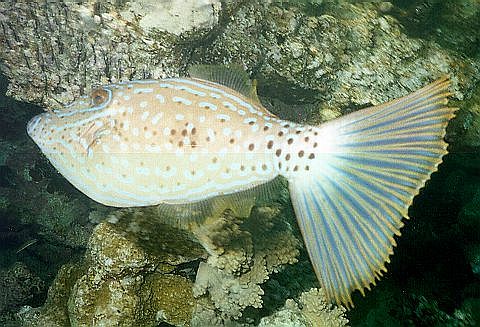 A red sea Scrawled
Filefish (Aluterus scripus). The scrawled filefish drifts over
reefs, and is often seen in open water. Their name comes from the first
dorsal spine, which locks into place and can only be released by the
second dorsal spine. Filefish
eat small fish and shrimp. The filefish are closely related to the
triggerfish. Thanks to Joshua for tracking this fish down for me!
This poor little guy was unidentified for years!
A red sea Scrawled
Filefish (Aluterus scripus). The scrawled filefish drifts over
reefs, and is often seen in open water. Their name comes from the first
dorsal spine, which locks into place and can only be released by the
second dorsal spine. Filefish
eat small fish and shrimp. The filefish are closely related to the
triggerfish. Thanks to Joshua for tracking this fish down for me!
This poor little guy was unidentified for years!
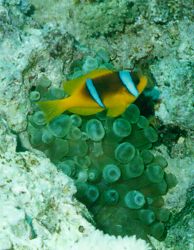
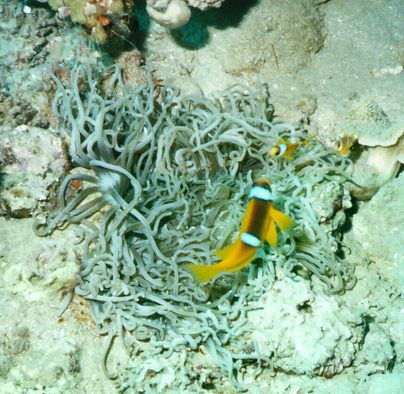
Several Two-Band
Anemonefish (Amphiprion Bicinctus),
swim safely amongst the venomous anemone, including the Bubble-Tipped
Anemone (right) and the Leathery
Sea Anemone (left). Anemonefish, aka clownfish, are a very specialized
species of damselfish that flutter in and out of anemone's poison-tipped tentacles in a
dance that would kill almost every other fish on the reef. They live in
symbiosis with the anemone in
which they make their home. They clean the anemone of unwanted matter in return for
the protection from predators that they get from living amongst the anemone.
© All pictures are Copyright 1998 - 2001 Grisel Gonzalez